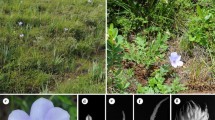rbcL
sequences of 11 of 15 extant species of Osmundaceae which represent all three genera, Osmunda, Todea and Leptopteris. Our phylogenetic analysis concluded: 1) Osmunda subg. Osmunda and subg. Plenasium are monophyletic groups, but subg. Osmundastrum is not. The genus Osmunda is not monophyletic because Todea and Leptopteris are positioned within Osmunda. 2) Osmunda cinnamomea is the most basally positioned species in Osmundaceae, and it can be called as “a living fossil” because a fossil species (O. claytoniites) with almost the same morphology as this species was recorded from the Triassic. 3) Osmunda japonica and O. regalis are very closely related with only one nucleotide difference in the rbcL gene. 4) Greater nucleotide variation (5–7 nucleotides) was found between conspecific samples of O. cinnamomea and O. claytoniana collected from Japan and United States. Each of these two species may comprise more than two biologically differentiated species.
Similar content being viewed by others
Author information
Authors and Affiliations
Additional information
Received 7 July 1999/ Accepted in revised form 25 August 1999
Rights and permissions
About this article
Cite this article
Yatabe, Y., Nishida, H. & Murakami, N. Phylogeny of Osmundaceae Inferred from rbcL Nucleotide Sequences and Comparison to the Fossil Evidences. J Plant Res 112, 397–404 (1999). https://doi.org/10.1007/PL00013894
Issue Date:
DOI: https://doi.org/10.1007/PL00013894




